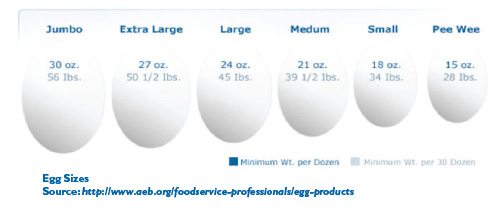
While most often found scrambled, poached, boiled, deviled, coddled or fried, the egg is a staple part of our diets and is also a key component in pastries and frozen desserts. How humans identified eggs for their nutritious benefits and functions in the kitchen is somewhat of a mystery—likely a result of trial and error and cultural evolution, as is the case with so many of the foods we consume today. Evidence suggests that wild fowl were domesticated as early as 3200 B.C., and were used for egg production and food beginning around 1400 B.C. Today, over 200 breeds of chickens have been identified; however, only a few are notable as egg producers, most of those in the U.S. being Single-Comb White Leghorns.¹ The eggs of many other fowl are also consumed—everything from quail to ostrich — however, the vast majority of eggs consumed and those that are used for cooking and baking originate from the chicken.
 The basic anatomy of the egg consists of the albumen (the egg white), which makes up about 66% of the egg’s total weight and contains the majority of the egg’s protein content. The yolk (round yellow portion) accounts for the other approximately 34% in weight, while containing the total fat content of the egg, some of the protein and the majority of the egg’s vitamins and minerals. The other main component of an egg’s interior is the air cell—the air pocket between the shell and the white at the large end of the egg. This pocket forms as a result of the contraction of the egg’s contents during cooling after the egg is laid.²
The basic anatomy of the egg consists of the albumen (the egg white), which makes up about 66% of the egg’s total weight and contains the majority of the egg’s protein content. The yolk (round yellow portion) accounts for the other approximately 34% in weight, while containing the total fat content of the egg, some of the protein and the majority of the egg’s vitamins and minerals. The other main component of an egg’s interior is the air cell—the air pocket between the shell and the white at the large end of the egg. This pocket forms as a result of the contraction of the egg’s contents during cooling after the egg is laid.²
Several factors influence the size of an egg, including the age of the hen (older hens lay larger eggs), the breed of the hen and also the weight of the bird.³ Eggs are classified by size, ranging from Pee Wee (minimum 15 oz. weight per dozen) to Jumbo (minimum 30 oz. weight per dozen).4 Eggs also undergo a grading process according to USDA standards and may be assessed as AA, A or B, with AA being the highest quality level. Eggs are graded on various factors including exterior shell shape, cleanliness and intactness, as well as a detailed interior inspection that assesses the white, the yolk and the air cell (higher grade eggs have a more shallow air cell—AA eggs may not exceed 1/8” in depth).5 Grade B eggs tend to be best-suited for uses such as scrambling and baking, when the shape of the egg will not remain intact. All eggs should be properly handled and cooked according to food safety principles (recommended 160°F) to avoid any potential for bacterial contamination.
Understanding the anatomy and complexities of the egg allows us to appreciate their use and function in our foods—especially baked goods and desserts. The functions of eggs are numerous, including a toughener (due to its protein content), a tenderizer (from the fat in the yolk), an aerator (both the yolks and the whites may be foamed, and the whites can be made into a meringue for aeration) and an emulsifier/stabilizer (lecithin in the egg yolks was actually the original stabilizing ingredient used in gelato). Whole eggs also serve to add color (from the carotenoids in the yolk) and rich flavor to finished products. Furthermore, the emulsifying properties of eggs help retard staling and prevent crystallization in candies, ice creams and frozen desserts. Eggs also add shine to baked goods (with an “egg wash” before baking) and act as edible glue (foods may be dipped in eggs then rolled in other ingredients, such as before frying).
Nowadays, there are many alternatives to fresh, whole shell eggs. Some geared towards home use and health-conscious individuals may blend egg whites with yolk replacements such as skim milk, gums, vegetable oils, etc., to create a liquid product aimed at serving the same function as whole eggs. Other egg products are made for commercial applications, with the intention of minimizing food cost, storage requirements and preparation time. In cases of large-scale production, pasteurized frozen or refrigerated liquid egg products, as well as dried egg products, provide a safe, uniform and user-friendly product for food production. It is important to note that egg products do not generally translate in quantity or function directly to fresh eggs.
For example, frozen yolks generally contain up to 10% sugar added, which lowers the freezing point and sweetens the product; therefore, you would need to take this into consideration with your specific recipe. Furthermore, a liquid egg white product that contains any fat will not allow you to whip or aerate the whites. Check labels and ingredient lists carefully, and note that different brands may yield different results; you should expect some trial and error when switching away from fresh eggs. Keep in mind the purpose of the eggs or egg products in your final goods, and this will help you maximize their functional and nutritional benefits.
References:
1 Egg Facts. 2011. Retrieved from American Egg Board:
www.incredibleegg.org/egg-facts [March 14, 2011].
2, 3, 5 Eggcyclopedia. 2011. Retrieved from American Egg Board:
www.incredibleegg.org/egg-facts/eggcyclopedia [March 14, 2011].
4 Foodservice Professionals: Egg Products. 2010. Retrieved from American Egg Board: http://www.aeb.org/foodservice- professionals/egg-products [March 14, 2011].

